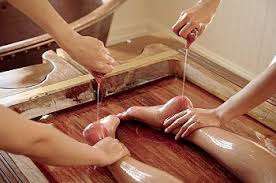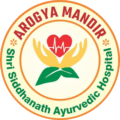Pizhichil

Introduction to Pizhichil
In the realm of holistic healing, Pizhichil stands out as a gem in the treasure trove of Ayurveda. This traditional Ayurvedic therapy, also known as “Thailadhara,” involves a unique blend of warmth, medicinal oils, and rhythmic massage. Let’s embark on a journey to explore the depths of Pizhichil and understand how it contributes to overall well-being.
A. Historical Roots of Pizhichil
The historical background of Pizhichil, an Ayurvedic treatment, can be traced back to the ancient text Ashtanga Hridaya, authored by Vagbhata Acharya. The text highlights the practice of pouring oil over the forehead, known as Shirodhara, and acknowledges its remarkable benefits for both physical and mental well-being. Pizhichil evolved from Shirodhara, maintaining the same therapeutic process with a slight modification in the location of oil pouring. While Shirodhara involves oil streaming onto the forehead, Pizhichil focuses on pouring warm medicated oil over the entire body. This treatment is also referred to as an “Oil bath” and is deeply rooted in traditional therapies originating from Kerala, India. The transition from Shirodhara to Pizhichil signifies an expansion of the therapeutic approach, demonstrating the adaptability and refinement of Ayurvedic practices over time.
B. Understanding the Ayurvedic Philosophy Behind Pizhichil
Pizhichil is a unique blend of two Ayurvedic therapies: Shirodhara and Sarvangadhara. Shirodhara involves the continuous pouring of warm medicated oil onto the forehead, focusing on balancing the Vata dosha and calming the nervous system. On the other hand, Sarvangadhara extends this practice to the entire body, providing a nourishing and rejuvenating experience.
The philosophy underlying Pizhichil is based on the belief that the body and mind are intricately connected, and imbalances in the doshas can manifest as physical or mental ailments. The warm medicated oil used in Pizhichil is selected based on the individual’s constitution and any specific imbalances present. The oil’s therapeutic properties penetrate the skin, promoting relaxation, improving circulation, and alleviating Vata-related disorders.
Pizhichil is considered particularly beneficial for conditions related to Vata dosha imbalance, such as joint pain, stiffness, and neurological issues. The continuous pouring of warm oil helps pacify Vata, reducing excess dryness and promoting lubrication in the joints and tissues.
Moreover, the rhythmic massaging and pouring of oil during Pizhichil stimulate the body’s energy channels, known as nadis, facilitating the flow of vital energy or prana. This aids in balancing the doshas and enhancing overall well-being.
Herbal Oils in Pizhichil
Central to Pizhichil is the use of herbal oils with therapeutic properties. Various oils are used in Pizhichil, an Ayurvedic therapy known for its rejuvenating and therapeutic effects. The choice of oil depends on the individual’s constitution (Prakriti), the specific health condition, and the dosha imbalance involved. Some commonly used oils in Pizhichil include:
- Sesame Oil (Tila Taila): Sesame oil is widely used in Pizhichil for its nourishing and warming properties. It is suitable for balancing Vata dosha and is often chosen for its ability to penetrate the skin.
- Coconut Oil (Narikela Taila): Coconut oil is known for its cooling and soothing properties. It is particularly beneficial for conditions where there is excess heat or inflammation.
- Dhanvantaram Oil: This herbal oil is a traditional formulation containing a blend of various herbs and is often used in Pizhichil. It is valued for its anti-inflammatory and rejuvenating properties.
- Mahamasha Taila: This medicated oil consists of potent herbs like Ashwagandha and Dashamoola, known for their anti-inflammatory and analgesic effects. It is commonly used in Pizhichil for addressing joint and muscle-related issues.
- Sahacharadi Taila: This herbal oil is recommended for individuals with Vata and Kapha imbalances. It contains herbs like Sahachara (Strobilanthes ciliatus) known for their anti-rheumatic and anti-inflammatory properties..
Procedure of Pizhichil Therapy
The Pizhichil therapy, also known as the “Oil Bath” or “Thaila Dhara,” is a unique and rejuvenating Ayurvedic treatment. The procedure involves the continuous pouring of warm, medicated oil over the entire body. Here is a step-by-step guide to the Pizhichil therapy:
1. Consultation and Assessment:
- The process begins with a consultation with an Ayurvedic practitioner. The individual’s health history, current health condition, and dosha imbalances are assessed to determine the suitability of Pizhichil.
2. Selection of Medicated Oil:
- Based on the individual’s dosha imbalance and specific health concerns, the Ayurvedic practitioner selects an appropriate medicated oil. Common oils include sesame oil, coconut oil, or specific herbal formulations like Dhanvantaram Oil.
3. Preparation of the Treatment Area:
- A comfortable and warm treatment area is arranged. Typically, a special table with a hollow center for the person to lie down is used.
4. Application of Oil:
- The individual lies on the treatment table in a relaxed position. The selected warm oil is then continuously poured over the entire body by trained therapists. The oil is spread evenly, ensuring that every part of the body receives the nourishing and therapeutic benefits.
5. Simultaneous Massage:
- While the oil is being poured, simultaneous gentle massage and strokes are performed by the therapists. This aids in the absorption of the medicinal properties of the oil, improves blood circulation, and enhances the overall therapeutic effect.
6. Duration of Treatment:
- The duration of Pizhichil can vary but typically lasts for about 45 minutes to an hour. The continuous pouring of warm oil creates a deeply relaxing and rejuvenating experience.
7. Post-Treatment Rest:
- After the therapy session, the individual is allowed to rest for a short period. The body absorbs the residual oil, and the therapeutic effects continue to unfold.
Benefits of Pizhichil on Physical Health
Pizhichil, an Ayurvedic therapy involving the continuous pouring of warm, medicated oil over the body, offers a range of physical health benefits. Some notable advantages include:
- Joint Health: Pizhichil is particularly beneficial for addressing joint-related issues, such as arthritis and stiffness. The warm oil helps lubricate the joints, reducing friction and promoting flexibility.
- Muscle Relaxation: The rhythmic pouring of oil and simultaneous massage in Pizhichil helps relax and rejuvenate muscles. It can alleviate muscle soreness, tension, and fatigue.
- Improved Blood Circulation: The gentle massage and warm oil stimulate blood circulation throughout the body, enhancing oxygen and nutrient supply to tissues and organs.
- Nervous System Support: Pizhichil has a calming effect on the nervous system, reducing stress and promoting relaxation. It can be beneficial for conditions such as insomnia, anxiety, and nervous disorders.
- Skin Nourishment: The medicinal properties of the oil used in Pizhichil nourish and rejuvenate the skin. It may improve skin texture, tone, and overall complexion.
- Detoxification: The warmth of the oil promotes sweating, aiding in the elimination of toxins from the body. This detoxifying effect can contribute to overall health and well-being.
- Enhanced Digestion: Pizhichil may support digestive health by calming the Vata dosha, which is associated with functions like digestion. Improved digestion can prevent issues like bloating and indigestion.
- Strengthened Immune System: Regular Pizhichil sessions may help boost the immune system by promoting overall vitality and balance in the body.
- Balanced Doshas: Ayurveda emphasizes the balance of the three doshas (Vata, Pitta, and Kapha) for optimal health. Pizhichil, by balancing Vata dosha, contributes to overall dosha equilibrium.
- Pain Relief: Individuals experiencing chronic pain, especially associated with Vata imbalances, may find relief through Pizhichil. It helps in reducing pain and promoting comfort.
Pizhichil’s Impact on Mental Well-being
Pizhichil, an Ayurvedic therapy involving the continuous pouring of warm, medicated oil over the body, has a profound impact on mental well-being. The therapy’s holistic approach addresses both physical and mental aspects, providing several benefits for mental health:
- Stress Reduction: The rhythmic pouring of warm oil combined with gentle massage induces a deep sense of relaxation. This helps in reducing stress levels, calming the mind, and promoting a state of mental tranquility.
- Anxiety Relief: Pizhichil’s soothing effects extend to alleviating anxiety. The warm oil and therapeutic massage contribute to a sense of comfort, easing tension and promoting mental calmness.
- Improved Sleep Quality: The calming influence of Pizhichil has positive implications for sleep. Individuals often experience improved sleep quality and may find relief from insomnia or sleep disturbances.
- Balancing the Nervous System: Pizhichil helps balance the Vata dosha, which is associated with the nervous system in Ayurveda. By calming Vata, the therapy supports overall nervous system health, reducing symptoms related to nervous disorders.
- Enhanced Mood: The relaxation induced by Pizhichil contributes to an improved mood. It may be particularly beneficial for individuals dealing with mood swings, irritability, or mild depressive symptoms.
- Mind-Body Connection: Ayurveda recognizes the interconnectedness of the mind and body. Pizhichil’s impact on physical health, such as joint and muscle relaxation, has a positive influence on mental well-being.
- Reduction of Mental Fatigue: Individuals experiencing mental fatigue or burnout may find relief through Pizhichil. The therapy’s calming effects help recharge the mind, reducing mental exhaustion.
- Promotion of Mindfulness: The therapeutic experience of Pizhichil encourages individuals to be present and mindful during the treatment, fostering a connection between the mind and body.
- Emotional Balance: Pizhichil’s calming influence contributes to emotional balance. It may aid in managing emotions and promoting a more stable and centered emotional state.
FAQs
- Pizhichil is generally safe, but individuals with specific health conditions should consult with an Ayurvedic practitioner before undergoing the treatment.
- The frequency of Pizhichil sessions varies based on individual health goals and conditions, with practitioners providing personalized recommendations.
- Pizhichil can benefit individuals of all ages, but the dosage and intensity may vary, especially for children and the elderly.
- Depending on individual health needs, Ayurvedic practitioners may recommend combining Pizhichil with other complementary therapies for enhanced benefits.
- While there are no strict dietary restrictions, practitioners may offer dietary guidelines to support the holistic effects of Pizhichil.
Uniqueness of our therapies
At Arogya Mandir – Shri Siddhanath Ayurvedic Hospital, Miraj, we delve deeply into the ayurvedic examination of each patient. Utilizing noninvasive Ayurvedic diagnostic tools such as Ashtavidha Parikshan and Nadi Parikshan, we precisely determine the pathogenesis of the disease and then prescribe therapies tailored to the specific condition. This approach leads to expedited results.
Our therapies boast the following distinctive features:
– Tranquil and hygienic therapy rooms staffed with trained therapists in a positive environment.
– Selection of appropriate massage oil based on the patient’s Prakruti and the condition of the disease.
– Complimentary Prakruti and Dhatu Sarata examinations before the commencement of therapies.
– Authenticated procedures for each therapy.
– Judicious use of herbal medicines and instruments during the therapy sessions.
– Specialized rooms equipped with all facilities for inpatient care.
Feel free to share this article at no cost.
Copyright message – Dr. Prashant Chivate has published this article on drchivateayurved.org for informational purposes about diseases. Any other use of this article is strictly prohibited. All rights reserved.
